Mengxi Liu
Passive Body-Area Electrostatic Field (Human Body Capacitance) for Ubiquitous Computing
Jul 17, 2025Abstract:Passive body-area electrostatic field sensing, also referred to as human body capacitance (HBC), is an energy-efficient and non-intrusive sensing modality that exploits the human body's inherent electrostatic properties to perceive human behaviors. This paper presents a focused overview of passive HBC sensing, including its underlying principles, historical evolution, hardware architectures, and applications across research domains. Key challenges, such as susceptibility to environmental variation, are discussed to trigger mitigation techniques. Future research opportunities in sensor fusion and hardware enhancement are highlighted. To support continued innovation, this work provides open-source resources and aims to empower researchers and developers to leverage passive electrostatic sensing for next-generation wearable and ambient intelligence systems.
TinierHAR: Towards Ultra-Lightweight Deep Learning Models for Efficient Human Activity Recognition on Edge Devices
Jul 10, 2025Abstract:Human Activity Recognition (HAR) on resource-constrained wearable devices demands inference models that harmonize accuracy with computational efficiency. This paper introduces TinierHAR, an ultra-lightweight deep learning architecture that synergizes residual depthwise separable convolutions, gated recurrent units (GRUs), and temporal aggregation to achieve SOTA efficiency without compromising performance. Evaluated across 14 public HAR datasets, TinierHAR reduces Parameters by 2.7x (vs. TinyHAR) and 43.3x (vs. DeepConvLSTM), and MACs by 6.4x and 58.6x, respectively, while maintaining the averaged F1-scores. Beyond quantitative gains, this work provides the first systematic ablation study dissecting the contributions of spatial-temporal components across proposed TinierHAR, prior SOTA TinyHAR, and the classical DeepConvLSTM, offering actionable insights for designing efficient HAR systems. We finally discussed the findings and suggested principled design guidelines for future efficient HAR. To catalyze edge-HAR research, we open-source all materials in this work for future benchmarking\footnote{https://github.com/zhaxidele/TinierHAR}
SImpHAR: Advancing impedance-based human activity recognition using 3D simulation and text-to-motion models
Jul 08, 2025Abstract:Human Activity Recognition (HAR) with wearable sensors is essential for applications in healthcare, fitness, and human-computer interaction. Bio-impedance sensing offers unique advantages for fine-grained motion capture but remains underutilized due to the scarcity of labeled data. We introduce SImpHAR, a novel framework addressing this limitation through two core contributions. First, we propose a simulation pipeline that generates realistic bio-impedance signals from 3D human meshes using shortest-path estimation, soft-body physics, and text-to-motion generation serving as a digital twin for data augmentation. Second, we design a two-stage training strategy with decoupled approach that enables broader activity coverage without requiring label-aligned synthetic data. We evaluate SImpHAR on our collected ImpAct dataset and two public benchmarks, showing consistent improvements over state-of-the-art methods, with gains of up to 22.3% and 21.8%, in terms of accuracy and macro F1 score, respectively. Our results highlight the promise of simulation-driven augmentation and modular training for impedance-based HAR.
Assessing the Impact of Sampling Irregularity in Time Series Data: Human Activity Recognition As A Case Study
Jan 25, 2025Abstract:Human activity recognition (HAR) ideally relies on data from wearable or environment-instrumented sensors sampled at regular intervals, enabling standard neural network models optimized for consistent time-series data as input. However, real-world sensor data often exhibits irregular sampling due to, for example, hardware constraints, power-saving measures, or communication delays, posing challenges for deployed static HAR models. This study assesses the impact of sampling irregularities on HAR by simulating irregular data through two methods: introducing slight inconsistencies in sampling intervals (timestamp variations) to mimic sensor jitter, and randomly removing data points (random dropout) to simulate missing values due to packet loss or sensor failure. We evaluate both discrete-time neural networks and continuous-time neural networks, which are designed to handle continuous-time data, on three public datasets. We demonstrate that timestamp variations do not significantly affect the performance of discrete-time neural networks, and the continuous-time neural network is also ineffective in addressing the challenges posed by irregular sampling, possibly due to limitations in modeling complex temporal patterns with missing data. Our findings underscore the necessity for new models or approaches that can robustly handle sampling irregularity in time-series data, like the reading in human activity recognition, paving the way for future research in this domain.
Enhancing Interpretability Through Loss-Defined Classification Objective in Structured Latent Spaces
Dec 11, 2024



Abstract:Supervised machine learning often operates on the data-driven paradigm, wherein internal model parameters are autonomously optimized to converge predicted outputs with the ground truth, devoid of explicitly programming rules or a priori assumptions. Although data-driven methods have yielded notable successes across various benchmark datasets, they inherently treat models as opaque entities, thereby limiting their interpretability and yielding a lack of explanatory insights into their decision-making processes. In this work, we introduce Latent Boost, a novel approach that integrates advanced distance metric learning into supervised classification tasks, enhancing both interpretability and training efficiency. Thus during training, the model is not only optimized for classification metrics of the discrete data points but also adheres to the rule that the collective representation zones of each class should be sharply clustered. By leveraging the rich structural insights of intermediate model layer latent representations, Latent Boost improves classification interpretability, as demonstrated by higher Silhouette scores, while accelerating training convergence. These performance and latent structural benefits are achieved with minimum additional cost, making it broadly applicable across various datasets without requiring data-specific adjustments. Furthermore, Latent Boost introduces a new paradigm for aligning classification performance with improved model transparency to address the challenges of black-box models.
Towards certifiable AI in aviation: landscape, challenges, and opportunities
Sep 13, 2024Abstract:Artificial Intelligence (AI) methods are powerful tools for various domains, including critical fields such as avionics, where certification is required to achieve and maintain an acceptable level of safety. General solutions for safety-critical systems must address three main questions: Is it suitable? What drives the system's decisions? Is it robust to errors/attacks? This is more complex in AI than in traditional methods. In this context, this paper presents a comprehensive mind map of formal AI certification in avionics. It highlights the challenges of certifying AI development with an example to emphasize the need for qualification beyond performance metrics.
A Wearable Multi-Modal Edge-Computing System for Real-Time Kitchen Activity Recognition
Sep 10, 2024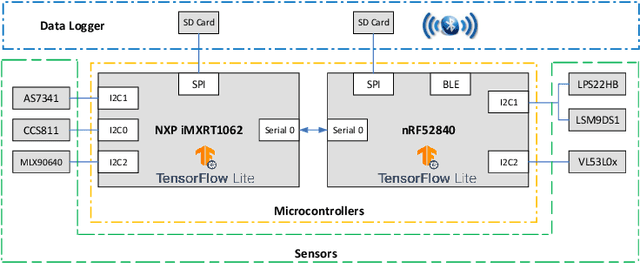



Abstract:In the human activity recognition research area, prior studies predominantly concentrate on leveraging advanced algorithms on public datasets to enhance recognition performance, little attention has been paid to executing real-time kitchen activity recognition on energy-efficient, cost-effective edge devices. Besides, the prevalent approach of segregating data collection and context extraction across different devices escalates power usage, latency, and user privacy risks, impeding widespread adoption. This work presents a multi-modal wearable edge computing system for human activity recognition in real-time. Integrating six different sensors, ranging from inertial measurement units (IMUs) to thermal cameras, and two different microcontrollers, this system achieves end-to-end activity recognition, from data capture to context extraction, locally. Evaluation in an unmodified realistic kitchen validates its efficacy in recognizing fifteen activities, including a null class. Employing a compact machine learning model (184.5 kbytes) yields an average accuracy of 87.83 \%, with model inference completed in 25.26 ms on the microcontroller. Comparative analysis with alternative microcontrollers showcases power consumption and inference speed performance, demonstrating the proposed system's viability.
ALS-HAR: Harnessing Wearable Ambient Light Sensors to Enhance IMU-based Human Activity Recogntion
Aug 22, 2024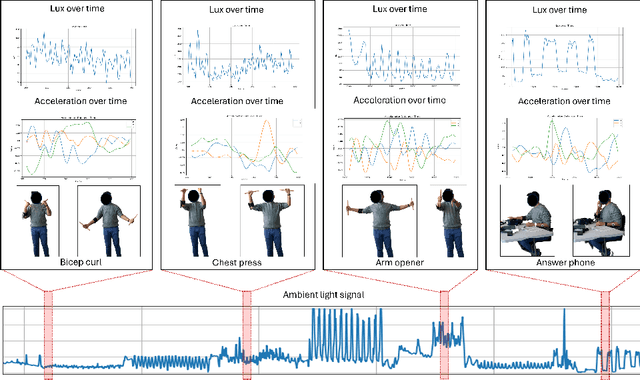
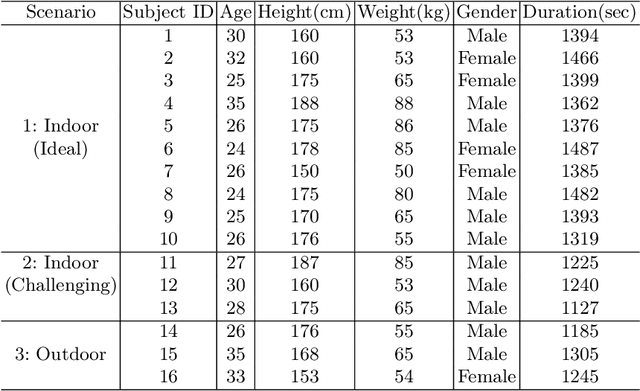
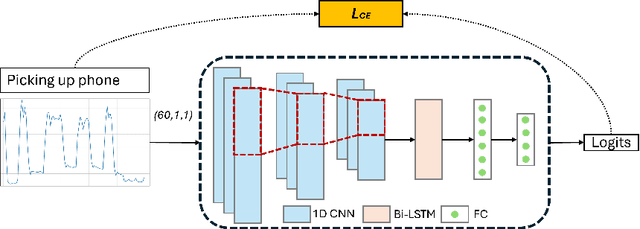
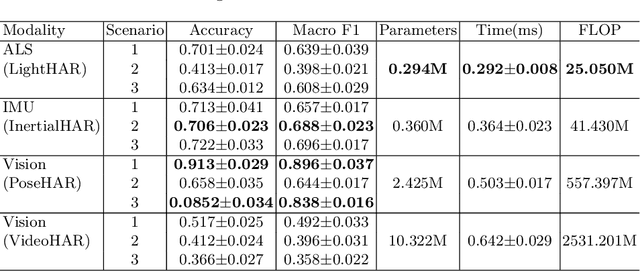
Abstract:Despite the widespread integration of ambient light sensors (ALS) in smart devices commonly used for screen brightness adaptation, their application in human activity recognition (HAR), primarily through body-worn ALS, is largely unexplored. In this work, we developed ALS-HAR, a robust wearable light-based motion activity classifier. Although ALS-HAR achieves comparable accuracy to other modalities, its natural sensitivity to external disturbances, such as changes in ambient light, weather conditions, or indoor lighting, makes it challenging for daily use. To address such drawbacks, we introduce strategies to enhance environment-invariant IMU-based activity classifications through augmented multi-modal and contrastive classifications by transferring the knowledge extracted from the ALS. Our experiments on a real-world activity dataset for three different scenarios demonstrate that while ALS-HAR's accuracy strongly relies on external lighting conditions, cross-modal information can still improve other HAR systems, such as IMU-based classifiers.Even in scenarios where ALS performs insufficiently, the additional knowledge enables improved accuracy and macro F1 score by up to 4.2 % and 6.4 %, respectively, for IMU-based classifiers and even surpasses multi-modal sensor fusion models in two of our three experiment scenarios. Our research highlights the untapped potential of ALS integration in advancing sensor-based HAR technology, paving the way for practical and efficient wearable ALS-based activity recognition systems with potential applications in healthcare, sports monitoring, and smart indoor environments.
Initial Investigation of Kolmogorov-Arnold Networks (KANs) as Feature Extractors for IMU Based Human Activity Recognition
Jun 16, 2024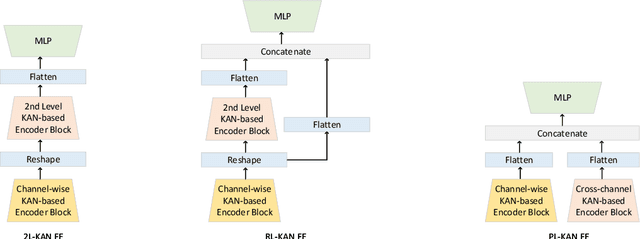
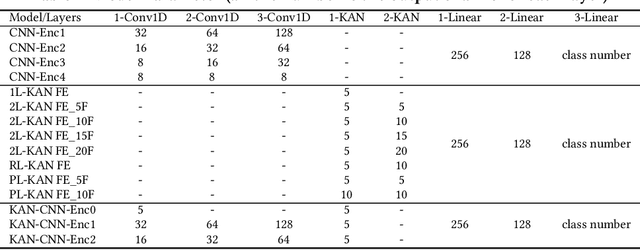
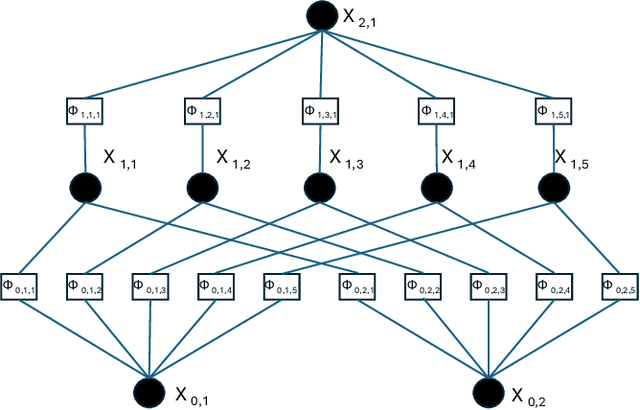
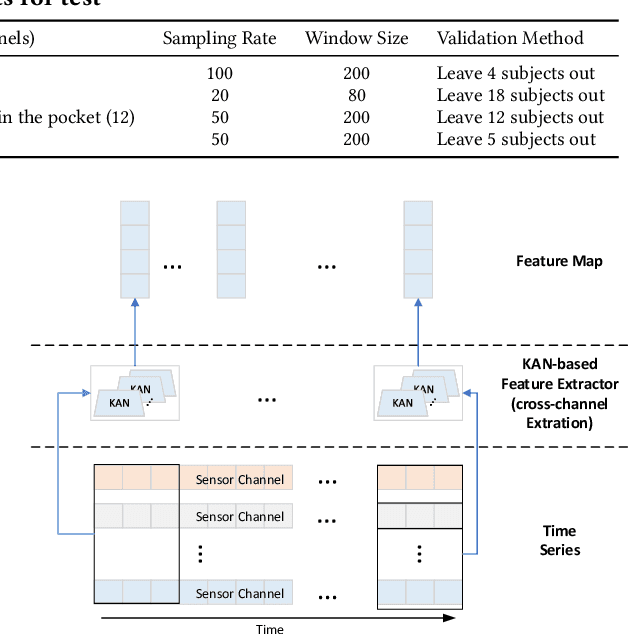
Abstract:In this work, we explore the use of a novel neural network architecture, the Kolmogorov-Arnold Networks (KANs) as feature extractors for sensor-based (specifically IMU) Human Activity Recognition (HAR). Where conventional networks perform a parameterized weighted sum of the inputs at each node and then feed the result into a statically defined nonlinearity, KANs perform non-linear computations represented by B-SPLINES on the edges leading to each node and then just sum up the inputs at the node. Instead of learning weights, the system learns the spline parameters. In the original work, such networks have been shown to be able to more efficiently and exactly learn sophisticated real valued functions e.g. in regression or PDE solution. We hypothesize that such an ability is also advantageous for computing low-level features for IMU-based HAR. To this end, we have implemented KAN as the feature extraction architecture for IMU-based human activity recognition tasks, including four architecture variations. We present an initial performance investigation of the KAN feature extractor on four public HAR datasets. It shows that the KAN-based feature extractor outperforms CNN-based extractors on all datasets while being more parameter efficient.
iKAN: Global Incremental Learning with KAN for Human Activity Recognition Across Heterogeneous Datasets
Jun 03, 2024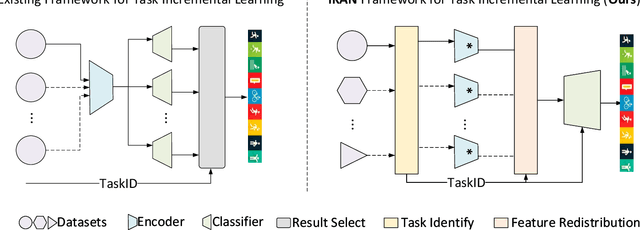

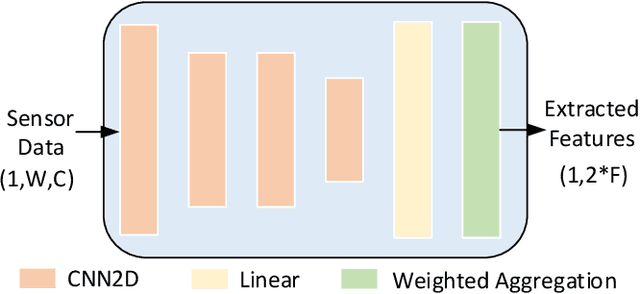
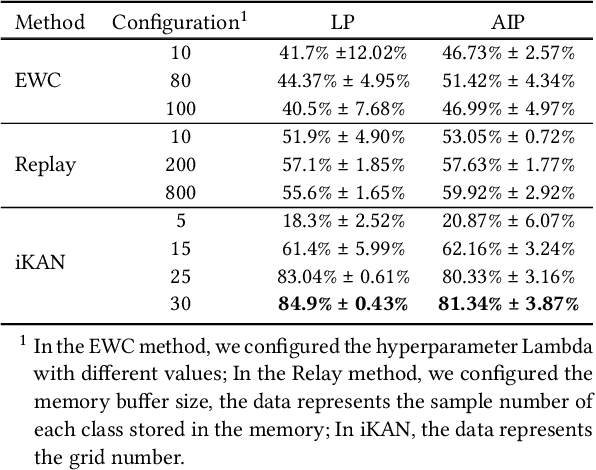
Abstract:This work proposes an incremental learning (IL) framework for wearable sensor human activity recognition (HAR) that tackles two challenges simultaneously: catastrophic forgetting and non-uniform inputs. The scalable framework, iKAN, pioneers IL with Kolmogorov-Arnold Networks (KAN) to replace multi-layer perceptrons as the classifier that leverages the local plasticity and global stability of splines. To adapt KAN for HAR, iKAN uses task-specific feature branches and a feature redistribution layer. Unlike existing IL methods that primarily adjust the output dimension or the number of classifier nodes to adapt to new tasks, iKAN focuses on expanding the feature extraction branches to accommodate new inputs from different sensor modalities while maintaining consistent dimensions and the number of classifier outputs. Continual learning across six public HAR datasets demonstrated the iKAN framework's incremental learning performance, with a last performance of 84.9\% (weighted F1 score) and an average incremental performance of 81.34\%, which significantly outperforms the two existing incremental learning methods, such as EWC (51.42\%) and experience replay (59.92\%).
 Add to Chrome
Add to Chrome Add to Firefox
Add to Firefox Add to Edge
Add to Edge